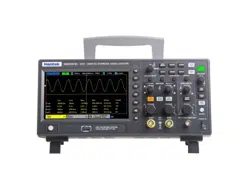Loading ...
Loading ...
Loading ...

User Manual
43 / 68
5. Turn V0 to select “Aa” and press V0 to confirm to set the input method to upper case.Turn V0 to select “DSOXXXX01”
and then press V0 to input the characters successively.
6. To delete the name in the name input area, press Switch Focus To softkey to switch to Name Input Area. Press the Delete
softkey continuously to delete the character on the left of the cursor one by one. Turn V0 to move the cursor position.
7. Press the Save softkey. The oscilloscope will create a file of the specified type under the current path with this file name
2.9.4.2. Delete a file or folder
This operation is only valid in external storage.
1. Insert the USB storage device, press the Save softkey in “Save/Recall” menu to enter the Save function menu.
2. Press the Type softkey, and then turn the Multifunctional Knob to select one type.
3. Use the SaveTo softkey to external location. Press Save softkey and into File Manager interface.
4. Turn the Multifunctional Knob V0 to select the file or folder to be deleted, and then press the Delete softkey. Then the file
or folder will be deleted.
2.9.4.3. Rename a file or a folder
This operation is only valid in external storage.
1. Insert the USB storage device, press the Save softkey in “Save/Recall” menu to enter the Save function menu.
2. Press the Type softkey, and then turn the Multifunctional Knob to select one type.
3. Use the SaveTo softkey to external location. Press Save softkey and into File Manager interface.
4. Turn the Multifunctional Knob V0 to select the file or folder, press the Rename softkey, and then refer to the descriptions
in “Create a new file” to create a new file name.
2.10. Measure System
The oscilloscope displays graphs of voltage - time and can help to measure the displayed waveform. There are several ways to
take measurements, using the graticule, the cursors or performing an automatic measurement.
2.10.1. Scale measurement
Graticule: This method allows you to make a quick, visual estimate and take a simple measurement through the graticule
divisions and the scale factor.
For example, you can take simple measurements by counting the major and minor graticule divisions involved and multiplying
by the scale factor. If you counted 6 major vertical graticule divisions between the minimum and maximum values of a
waveform and knew you had a scale factor of 50mV/division, you could easily calculate your peak-to-peak voltage as follows:
6 divisions x 50mV/division = 300mV.
2.10.2. Cursor measurement
Cursor: This method allows you to take measurements by moving the cursors. Cursors always appear in pairs and the displayed
readouts are just their measured values. There are two kinds of cursors: Amplitude Cursor and Time Cursor.
Loading ...
Loading ...
Loading ...
